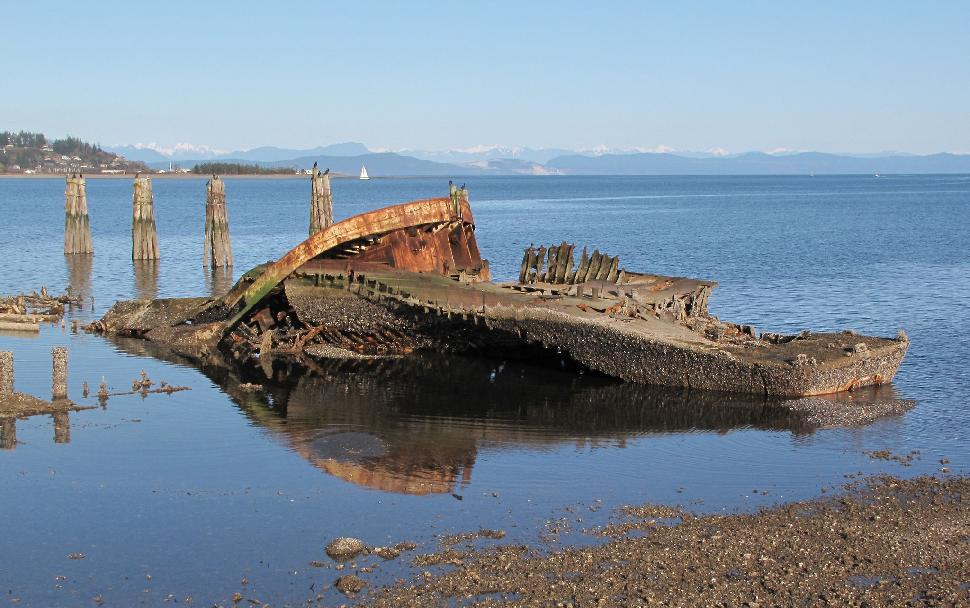1. Pesuta
Haida Gwaii

Location: Tlell River, Haida Gwaii
What to see: The remains of the wooden hull lay upon the beach just north of the Tlell River and is a popular spot for tourists, especially photographers. It makes for a great photo op for children and adults alike, especially while looking through the portholes. Be sure to consult a tide table to make sure you’ll get a proper visit!
Historical Relevance: The Pesuta was a 264 foot log barge that ran into trouble upon a voyage in a winter storm on Dec. 11, 1928. It was being towed behind the tugboat Imbrecaria when a heavy gale struck the pair, causing the tow cables to snap, and both cargo and barge were lost to the elements. Originally a Ferris freighter built for the U.S. Shipping Board emergency shipbuilding program during WWI, the barge ran aground of the beach, with multiple attempts to recover it fruitless. Instead, the ship was left to slowly decompose over the past 90 years.

How to get to the Pesuta: You can visit the remains of the Pesuta via the Pesuta Shipwreck Hike, which starts at the Tlell River Bridge day use area. It’s a 10 kilometre hike, and estimated to take about four hours on average to complete.
2. Michigan
Vancouver Island
Location: About two kilometres east of Pachena Point, 12 kilometres into the West Coast Trail
Things to do: This is the first wreck of the Graveyard of the Pacific where you will definitely find some cool leftovers, such as a boiler, from the ship. Especially neat, considering this ship crashed over a hundred years ago.
Historical Relevance: Headed from Puget Sound to San Francisco in January 1893, this wooden steamship ran into trouble when it encountered a northerly current. This current, the demise of many ships in the Graveyard, pushed the Michigan straight into Vancouver Island instead of its intended target, the Juan de Fuca Strait. Fortunately, only one crew member died of exposure, as the rest survived when they grabbed a life raft and floated down to Neah Bay for assistance.
How to get to the Michigan: You’ll need to start at the Pachena trailhead, which is five kilometres south of Bamfield. Driving from Port Alberni you can expect about an hour or two long drive, but if you’re worried about navigating the steep and winding path, there are alternative ways to get there. Hop on a bus from Victoria, Nanaimo or Port Alberni and just take in the sights.
From here, you start the West Coast Trail, home to too many shipwrecks. Be prepared, this hike will take multiple days. But it will provide plenty of opportunity to find splinters of wrecks from the past. At the 12 kilometre mark you’ll find the Michigan.
3. Uzbekistan
Vancouver Island
Location: Mouth of Darling Creek, on the West Coast Trail on Vancouver Island
Things to do: At low tide, you can comb the beach for pieces of shrapnel left behind by the wreckage of the Uzbekistan. You’ll probably spot portions of the steel hull, but most larger parts have long ago been looted.
Historical Relevance: It is still unknown exactly why this ship crashed onto shore, nevertheless running straight into it, but there are theories. One such is that a lighthouse blackout put in effect on June 20, 1942, after Japanese submarines were spotted off the coast, caused the captain to become disoriented on the crew’s return trip to Russia. Leaving the West Coast, the vessel was meant to return to Vladivostok, Russia, but didn’t make it very far. On April 1, 1943, the crew of 50 were forced to abandon ship and head back inland when the Uzbekistan met its fate.
How to get to the Uzbekistan: Continue two kilometres past the Michigan wreck.
4. Valencia
Vancouver Island
Location: South of Pachena Point, 18 kilometres into the West Coast Trail from the Pachena Trailhead
Things to do: You can search the beach for debris and remains of the Valencia, where you’ll also find a small portion of the ship. Alternatively, if you’re into diving, you can find more remnants further out from the shore, though it is illegal to remove anything from the site.
Historical Relevance: Also apart of the West Coast Trail, you’ll come to see why the southwest coast of the island became known as the Graveyard of the Pacific. Setting out from San Francisco on its journey to Alaska, with a stop in Victoria, and a crew of 65 and 110 paid passengers, the Valencia had braced only calm weather. However, stormy weather obscured the path before the Juan de Fuca Strait and the ship crashed into a rock, before being barraged by constant waves and wind. The captain ordered the ship beached, and it ended up about 80 metres from shore. But panic for the passengers didn’t set in until the onboard electricity went out. Everyone scrambled for the lifeboats, which were mistakenly released, and subsequently capsized. Only 37 passengers survived the wreck, even though the Valencia took 36 hours to sink in January, 1906.
How to get to the Valencia: Continue another four kilometres past the wreck of the Uzbekistan.
5. Royston Wrecks
Comox Valley, Vancouver Island

Location: Comox Harbour, just north of Vancouver
Things to do: A local kayak company offers kayaking tours of the wrecks, as well as the local wildlife.

Historical Relevance: Also referred to as the Ghost Ships of Royston, these ships were sunk purposely in order to create a breakwater for the harbour. Local loggers, starting in the late 1930s, began sinking old ships of various size and purpose to help calm the perilous waters that would often slow down their lumber production because of hazardous conditions. The ships were towed into the harbour then drilled full of holes, making navigation of the waters much more manageable.
How to get to the Royston wrecks: You can find the Comox Valley Kayaks tour company in Courtenay, right at the Courtenay Marina Park.
This article was originally featured on BCMag.com on April 18, 2016.




